FIELD TRIP II:
ART & MEMORIAL


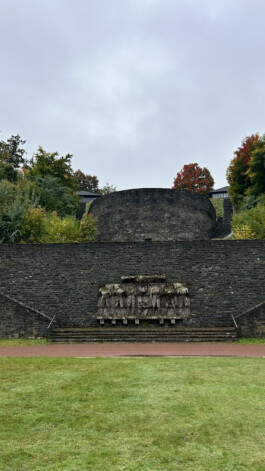

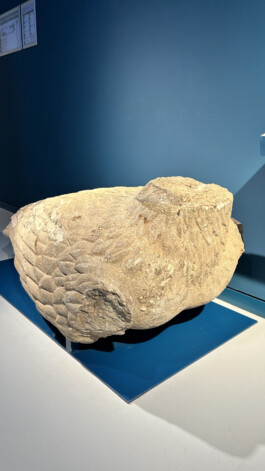
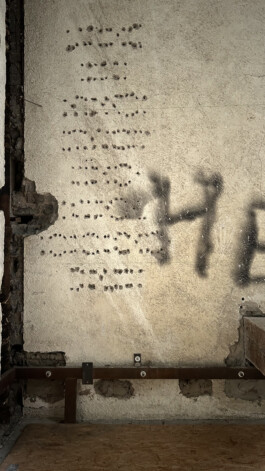



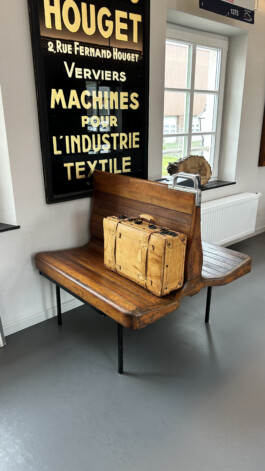
Impressions of Vogelsang IP, with remnants of former Nazi buildings and ornaments, and the Vieille Montagne Museum in Kelmis; pictures: Nathalie Schulz
Date
October 6th-7th
Vogelsang IP in Eifel National Park
and Museum Vieille Montagne in Kelmis (Belgium)
For our second field trip, this year's Borderland Residencies group ventured deep into the Eifel National Park to visit the former Nazi Ordensburg Vogelsang. There, they were confronted with the questions that arise when the remnants of a fascist state and its artworks are returned to state ownership. The following day, we travelled to the Museum Vieille Montagne in Kelmis, Belgium, for a contrasting programme.
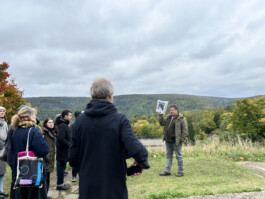
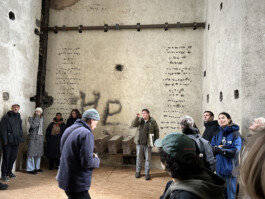
We spent the first day of the field trip at Vogelsang IP in the northern Eifel region. This site has a stark history as a Nazi Ordensburg, one of three built between 1934 and 1941 to mould the next generation of NSDAP leaders. Perched on a wooded mountain spur, the site's monumental architecture was deliberately designed to inspire awe and convey the supposed superiority of the 'master race'. It is a powerful and unsettling reminder of how art and space can be weaponised for indoctrination, and it confronts us with the question of how we should deal with the remnants of this dark period today.
After sharing a lunch at the Panorama Restaurant, we headed out with Stefan Wunsch, the scientific director, who led us on a thoughtful tour of the Vogelsang grounds. Highlights included the Adlerhof complex, a former seminar room housing the 'Ehrenhalle', and rooms not usually open to the public such as the Burgschänke. We also caught a glimpse of the torchbearer relief, the Sonnwendplatz, the sports facilities, and the open-air stage, all of which echo the period's claim to power and its eventual uses.
The post-war story is one of pragmatic conversion. Vogelsang was used as a training ground for the British and later the Belgian military until 2005. Many parts of the buildings were repurposed. For instance, the tower of the Hall of Honour was converted into a climbing wall and the swastika on the floor was covered with foam mats. Some former symbols, such as the eagle sculptures, were decapitated, while others were left intact. After 2005, ownership of the site and buildings was returned to the German state, which had to decide what to do with them next. Should the site be left to fall into disrepair, risking it becoming a neo-Nazi pilgrimage site? Or should everything be demolished in an attempt to erase the past? Or should the site be given a new purpose by turning it into a memorial where educational work is carried out, as was ultimately decided? The site opened as a national park in 2004, and by 2006 it was accessible to international visitors. Vogelsang IP Gemeinnützige GmbH was founded in 2008, and in 2016 the Forum Vogelsang IP joined the Eifel National Park Centre, broadening its educational remit.
Today, Vogelsang IP stands as a place of remembrance, education and critical reflection. Stefan Wunsch provided us with an insight into the permanent exhibition, 'Destiny: Master Race. NS Order Castles between Fascination and Crime”, offering insight into current remembrance practices at the site. It invites visitors of all ages to engage in active exchange, reflection and action, turning memory into learning and dialogue rather than mere spectacle.
Vogelsang IP therefore shows how places with extreme histories can be transformed into educational spaces that encourage visitors to confront the past and consider its relevance to current social issues.
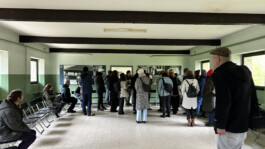
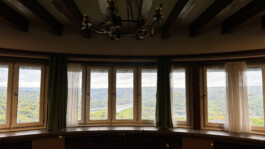

After the extensive tour, we returned to our guesthouse, which is located on the Vogelsang site. Here we had an in-depth discussion with Stefan Wunsch and Julia Schaadt. Both took a lot of time to answer questions and discussed their thoughts on the work and impact of the site with the group participants.


On the next day, we crossed the border and went to Kelmis (La Calamine), which is located in German-speaking East Belgium, near Aachen, in the province of Liège. The name is derived from the ore calamine, from which zinc was extracted. Due to these raw material deposits, Kelmis was the center of zinc ore mining in the 19th century and the scene of a unique political phenomenon: the neutral territory of Neutral-Moresnet, which was created as an international compromise between Prussia and the Netherlands and existed until 1918. Today, Kelmis is a dynamic community with a cultural focus on its industrial history and a lively club and museum scene that is strongly influenced by the heritage of the Vieille Montagne.
We visited the Vieille Montagne Museum, housed in the former headquarters of the zinc company. The building itself is a fine Art Nouveau landmark, and inside we explored a rich permanent exhibition on mining and zinc processing, the curious history of Neutral Moresnet, and the social life shaped by the Vieille Montagne company. The museum does a great job linking industrial heritage with questions of identity and cross-border cooperation, offering a deeper sense of how this region’s past continues to echo in the present.
Guided by museum director Jan Cetinkaya, our group wandered through thoughtfully curated displays that highlight local entrepreneurs like Jean-Jacques Dony and François-Dominique Mosselman, while also reflecting on memory and Europe’s shared responsibilities. After an engaging tour, we shared a communal lunch in Kelmis, and although the official journey ended, the conversations about memory, identity, and cooperation lingered on—reminding us that learning from the past can fuel better collaboration in the future.